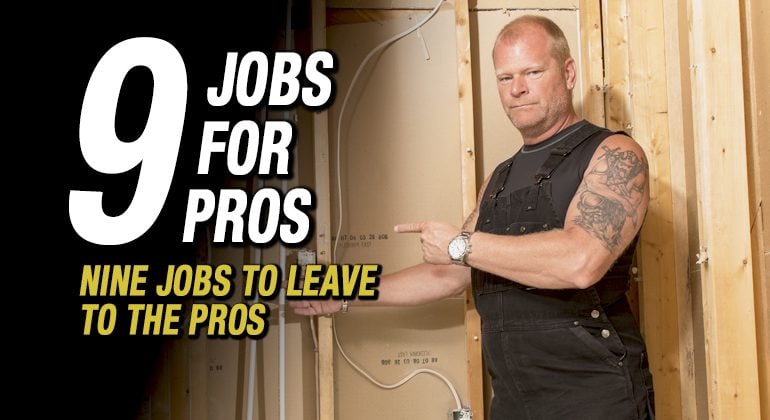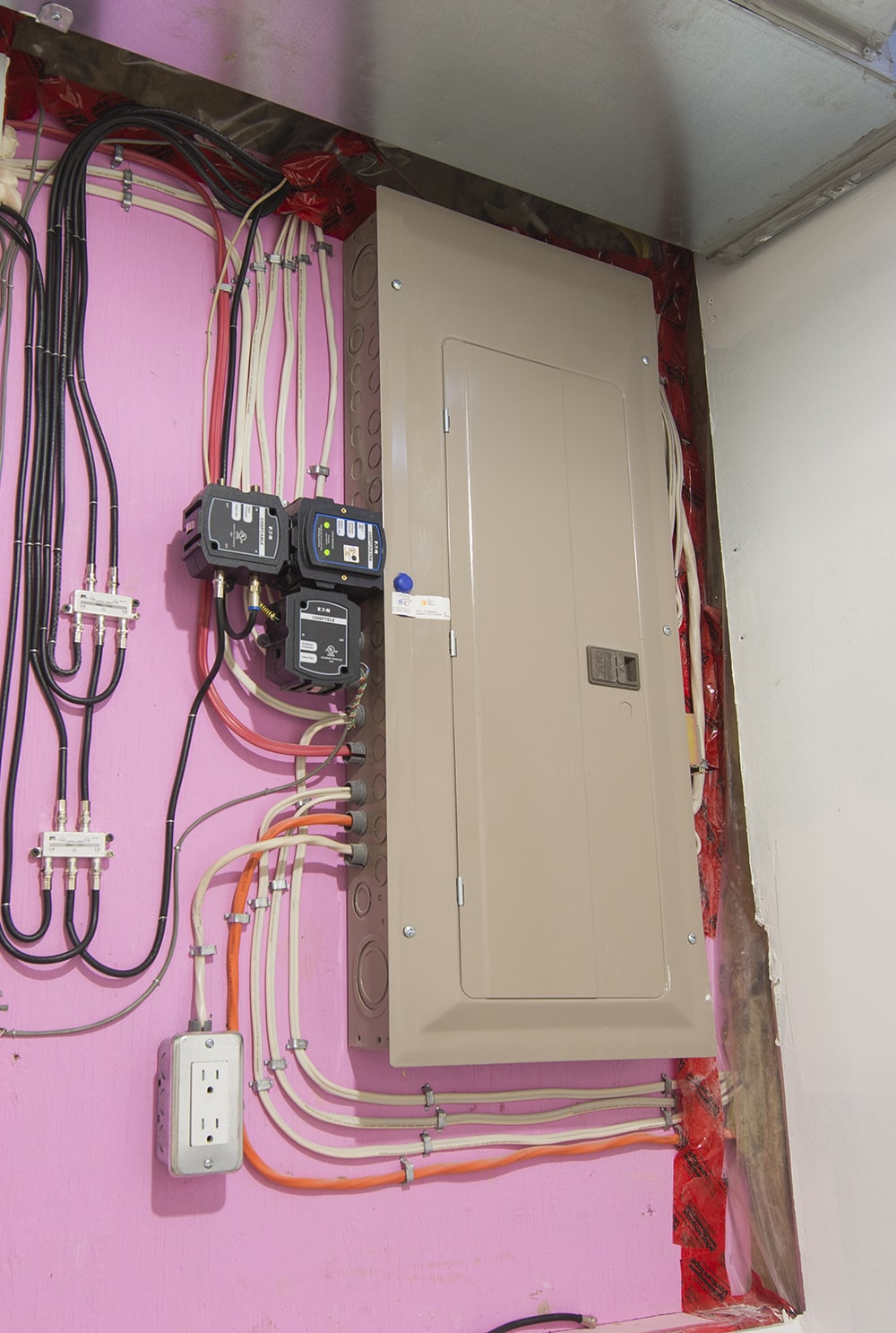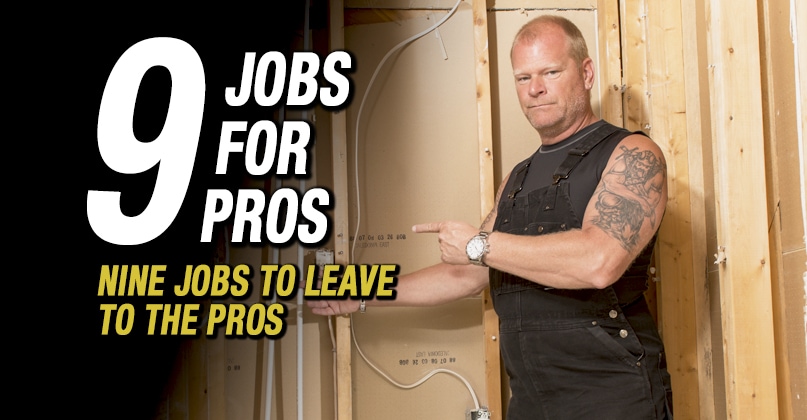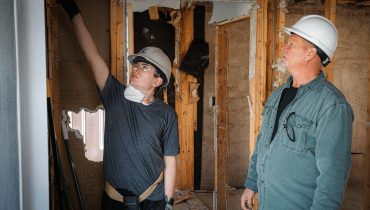For years I’ve been talking about protecting your home from the outside-in. And that includes protecting it against water intrusion. You always want water to move AWAY from your home’s...

Nine Jobs To Leave to the Pros
By Mike Holmes
Mike’s Advice / Bathroom Renovation
Thursday, May 6th, 2021 @ 4:01pm
I get the desire to do your own work around the house. With YouTube videos and other online tutorials, DIY projects are more accessible than ever. And look, the idea that you can save a few bucks doing your own work is an appealing one, but there are limits to everyone’s skills when it comes to DIY.
If you want to tackle some minor work, or cosmetic projects, I think that’s manageable for anyone who’s handy – but there are home improvement projects that MUST be handled by a professional.
Here are nine jobs that you should leave to the pros.
9. Plumbing
If there’s one thing roughing it teaches you – it’s an appreciation for indoor plumbing.
Your home’s plumbing is a complex and intricate system, and it’s not something you should do on your own. When you do your own plumbing work, you could create a mess of your lines, or cause flooding somewhere in your home.

Licensed plumbers have years of experience and on the job training. They know how to properly work with your systems to ensure everything is done to code, and done safely.
Minor plumbing related jobs you COULD do are swapping out your sink fixtures, or doing some simple cleaning and maintenance of your existing taps. Everything else should be left to a professional.
READ MORE:
Stay Away from DIY Water Filtration Systems
|
I highly recommend getting a water test first and then working with professionals to determine your needs. I love the service and products Kinetico Water Systems provided to me |
I wouldn’t even recommend installing your own water filtration system. Unless you have your water tested by a professional, you don’t know the specific issues you need to resolve.
Did you know that Water Treatment and Filtration systems sold in hardware stores are one of the most commonly returned items? That’s because homeowners think they aren’t working. The truth is, you haven’t uncovered exactly what is wrong with your water so how do you know if the filtration system is working or not?
8. Electrical
Your electrical system – when not installed or inspected by a professional is a serious fire hazard. The second leading cause of house fires are due to electrical problems (the first are cooking related fires). They make up about 15 percent of all fires in Canada.
That’s why it makes me so nervous to hear when homeowners tackle their own electrical work. You have seen my shows, right? If you don’t know what you’re doing, not only could you be increasing your risk of an electrical fire – you may be at risk of electrocution if you install something incorrectly.
For your own safety – bring in a Licensed Electrical Contractor. They know code, so they can update your wiring to ensure it’s safe. They can also look at your existing setup and diagnose any potential issues, possibly saving you from an electrical fire down the line.
In Ontario, make sure you hire a licensed electrical contractor. The Electrical Safety Authority can help you there.

This is an Eaton panel installed at our latest job.
7. HVAC
Think of your heating, ventilation, and air conditioning (HVAC) as the lungs of your home. It helps regulate airflow in your home – and with proper ventilation keeps mold and mildew growth at bay. If you start messing around with your HVAC system, you are asking for trouble.
If you have a heat recovery ventilator (HRV) or energy recovery ventilator (ERV) your HVAC can also promote a healthy air exchange in your home, by cycling out the stale, moist air from your home, and bringing in fresh, treated air from the outdoors.

You wouldn’t want anybody but a doctor working on your lungs – and the same is true for your HVAC system.
READ MORE:
6. Tile Work
When we set new tile in our projects, my go-to is always my daughter, Sherry Holmes. However, she didn’t start out as a pro-tiler – it took years for her to become great at the skill. It isn’t something that happens overnight.
When tile is done properly – it can enhance a room and provide a seamless look that works in pretty much any style. Your tile can mimic hardwood or other designs while still retaining the benefits of using tiles in the first place.
When done poorly, you’ll likely see tile lain unevenly, or even began to crack and break apart over time. Amateur work often costs you more in the long run when you have to redo the shoddy work.
This goes for any kind of flooring including carpet and hardwood. Why spend all that money to obtain premium flooring just to cheap out on the install? Do it right, and have it installed by a pro.
You also need to make sure you have the knowledge and skills needed to prepare your floor BEFORE the beautiful tiles go on. For example, if you don’t level your floor, you will end up with dips and squeaks.
Not a lot of people have the knowledge and skills to install a waterproofing system under your tiles. We love the Schluter System, but I wouldn’t recommend that as a DIY job. |
5. Installing Cabinets
Nothing’s more exciting than a kitchen renovation – I’ve noticed that’s where many homeowners really dream big. And it makes sense, the kitchen is the central hub of many homes.
When redoing your cabinets, I wouldn’t handle the installation on my own. Think about it – cabinets are heavy objects, plus think about what goes into them: plates, glasses, food items – all added weight.
When not installed properly – by anchoring them securely into the wall, and ensuring they can handle the excess load of what will be stored inside, they may come crashing down. Not only will that likely cause whatever’s inside to shatter – if somebody is nearby, they could get seriously hurt.
4. Asbestos Removal
Asbestos used to be a common building material, though thankfully we no longer use it. But many older homes still contain asbestos. As long as you don’t disturb it, it’s generally safe, but when you’re removing building materials that have asbestos you cannot remove it yourself.
You have to bring in an asbestos abatement company so they can safely remove and dispose of the materials.

This is something even my crew leaves to the pros. Don’t do it yourself.
3. Mold Remediation
Mold needs three ingredients to thrive: moisture, a source of food, and air. If you remove one of these ingredients, you can stop mold growth in its tracks. That means keeping moisture at bay in your home. If that doesn’t happen, you’ll find that mold growth can get out of control.
If you discover mold, you need to call a mold abatement company. Not only will the properly remove the mold, they can find the source of the problem. Because if you don’t eliminate that source of moisture, you’re going to see mold growth again and again.

When inhaled, mold can cause respiratory issues, or rashes and eczema when they come in contact with the skin.
If the mold is less than 10 sq/ft then you can remove it yourself, but anything larger needs to be dealt with by a pro.
2. Installing A New Roof
Your roof is a major line of defense against the elements. With a strong roof, you can keep rain, snow, sleet, moisture, and mold out of your home. You can do a visual check of your roof to make note of any weak points. You’re looking for things like curling or missing shingles, or granules gathering in your eavestrough.
But when it comes to making roof repairs or installing a new roof, leave that to the experts. Even in the best of conditions, working at heights is dangerous. Professional roofers know how to safely work on your roof, and they know how to install your roof to code.
Not only that, when they take down your old roofing materials, they can assess the health of your roof deck and make any needed repairs before laying your new material down.
When it comes to your roof install, you should be involved in picking the shingle style and colour – but leave the installation to a professional.
If you are in the US, check out Atlas Roofing to find a roofing contractor. |
RELATED:
1) Structural Changes
Are you dreaming of an open concept space? Don’t pull out your sledgehammer and start knocking down walls on your own. You’ll need the knowhow of a good contractor, plus an architect.
Why? Because there’s no simple trick to assessing whether or not a wall is loadbearing.

If you knock down the wrong wall without guidance, you will eventually see some sagging, or in extreme cases, collapse from removing that load bearing structure.
A professional team can assess whether or not that wall is loadbearing, and if it is, how to properly support your structure so that it continues to stand tall.
READ NEXT:
About Mike Holmes:
Mike Holmes is a renowned Canadian contractor, TV personality, and passionate advocate for the skilled trades.









